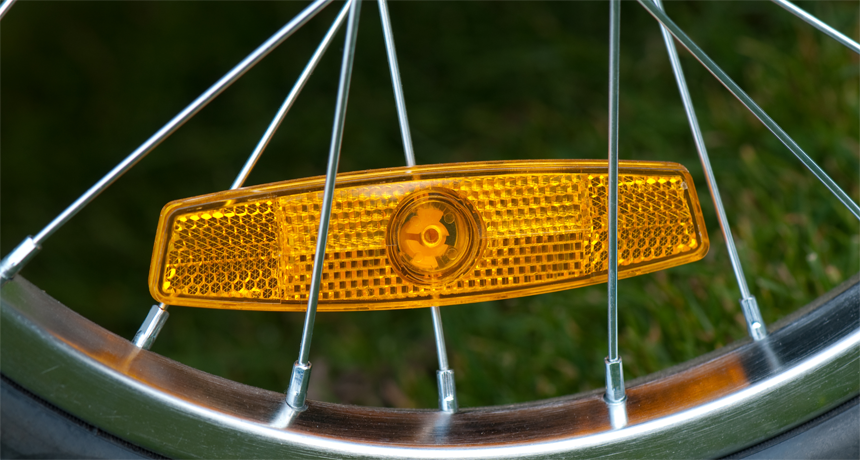Teen’s invention could help light up bikes at night
Battery-free lights are powered by the flexing of the tires

Bike reflectors like this one could become a thing of the past, if a nifty new light designed by a teen becomes widespread.
schulzie/ iStockphoto
By Sid Perkins
LOS ANGELES, Calif. — A battery-free light invented by a teen from Georgia could replace the reflectors on a bike’s spokes. Its power comes from a flexing of the tires as a bike is ridden. The new device could save plenty of lives, its inventor suggests.
Only one in five bicyclists ride at night, says Thomas Dorminy. But in 2014, a whopping half of cyclist deaths occurred at dusk, dawn or nighttime, notes this 12th-grader at Sola Fide Home School in McDonough, Ga. (That statistic come from the National Highway Traffic Safety Administration.) One way to decrease the number of fatal bike accidents, the 19-year old thought, would be to make bikes more visible to other vehicles.
Lights on bikes are often designed to illuminate the road. That’s why they point forward. But seen from the side, the only visible safety devices are the reflectors attached to a wheel’s spokes. Those devices reflect light from a car’s headlights back at drivers. That means the cyclist can be largely invisible to a driver who hasn’t turned a car’s lights on.
The teen decided to make a device that doesn’t depend on a car’s headlights. It glows on its own. Better yet, it never needs a battery because it’s powered by small bits of a piezoelectric (PEE-eh-zoh-eh-LEK-trik) material. When such materials flex, electrons move inside them to generate an electric current. (The “piezo-” prefix comes from the Greek word piezein. It means “to squeeze” or “to press.”)
Thomas showcased his research, here, at the Intel International Science and Engineering Fair. ISEF was created by Society for Science & the Public and is sponsored by Intel. The competition lets students from around the world show off their winning science fair projects. (The Society also publishes Science News for Students.) Last week, nearly 1,800 high school students from more than 75 countries competed for big prizes and the ability to share their research findings.
In his design, Thomas connected three small bits of piezoelectric material and placed them between the bike’s tire and its inner tube. Every time the tire rotates down to make contact with the street or sidewalk, weight presses on the piezoelectric bits. The current this generates lights a small strip of light-emitting diodes, or LEDs. These lights are attached to the spokes of the bike’s wheel, where a reflector would normally call attention to the wheels. When the bike rolls off the piezoelectric bits, the materials flex back to their normal shape. That creates a second surge of current and another flash of light.
The device’s strip of LEDs measures about 5 centimeters (2 inches) long. When sitting still, the strip is only about one-fifth the size of a standard bicycle reflector, Thomas points out. But when the bike’s wheel is rotating, the strip of glowing LEDs creates a bright swath of light that measures almost 150 square centimeters (23 square inches). That’s about six times the area of a reflector. Moreover, this glow would be brighter than a standard reflector. So Thomas says it’s almost certain that his device would be seen more easily than the reflectors used on bikes today.







